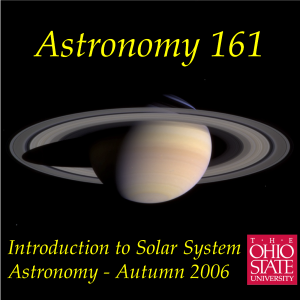
Astronomy 161 - Introduction to Solar System Astronomy
Education:Courses

How do the planets move across the sky? This lecture will review
planetary motions, specifically the apparent motions of the five
classical planets (Mercury, Venus, Mars, Jupiter, and Saturn) as seen
from the Earth. We will discuss the classical division of the
naked-eye planets into inferior (Mercury and Venus) and superior
(Mars, Jupiter, and Saturn) planets, and describe their main configurations
in the sky: conjunction, opposition, maximum elongation, and quadrature.
We will then discuss retrograde motion, the apparent westward reversal of
motion seen at opposition in the superior planets and inferior conjunction in
inferior planets. The quest to describe the very complex motions of the
planets marks the birth of science, and will be the central theme of next
week's lectures. Recorded 2006 Oct 5 in 100 Stillman Hall on the
Columbus campus of The Ohio State University.
view more
More Episodes
Lecture 27: Deep Time - The Age of the Earth
 2006-10-30
2006-10-30
 2006-10-30
2006-10-30
Lecture 26: Telescopes
 2006-10-27
2006-10-27
 2006-10-27
2006-10-27
Lecture 25: Measuring Light - Spectroscopy
 2006-10-26
2006-10-26
 2006-10-26
2006-10-26
Lecture 24: Matter and Light
 2006-10-25
2006-10-25
 2006-10-25
2006-10-25
Lecture 23: Worlds Within: Atoms
 2006-10-24
2006-10-24
 2006-10-24
2006-10-24
Lecture 22: Light the Messenger
 2006-10-23
2006-10-23
 2006-10-23
2006-10-23
Lecture 20: Tides
 2006-10-18
2006-10-18
 2006-10-18
2006-10-18
Lecture 19: Orbits
 2006-10-17
2006-10-17
 2006-10-17
2006-10-17
Lecture 16: Galileo and the Telescope
 2006-10-12
2006-10-12
 2006-10-12
2006-10-12
Lecture 15: The Watershed: Tycho and Kepler
 2006-10-11
2006-10-11
 2006-10-11
2006-10-11
Lecture 13: Greek Astronomy
 2006-10-09
2006-10-09
 2006-10-09
2006-10-09
Lecture 11: The Calendar
 2006-10-04
2006-10-04
 2006-10-04
2006-10-04
Lecture 10: Telling Time
 2006-10-03
2006-10-03
 2006-10-03
2006-10-03
Lecture 9: Eclipses of the Sun and Moon
 2006-10-02
2006-10-02
 2006-10-02
2006-10-02
Lecture 8: Phases of the Moon
 2006-09-29
2006-09-29
 2006-09-29
2006-09-29
0123456789101112131416171819
Create your
podcast in
minutes
- Full-featured podcast site
- Unlimited storage and bandwidth
- Comprehensive podcast stats
- Distribute to Apple Podcasts, Spotify, and more
- Make money with your podcast
It is Free
- Privacy Policy
- Cookie Policy
- Terms of Use
- Consent Preferences
- Copyright © 2015-2024 Podbean.com



